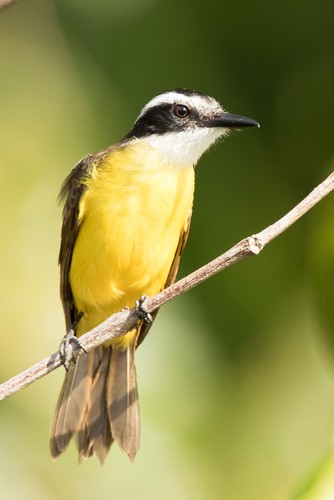Lesser Kiskadee
A species of Kiskadees Scientific name : Philohydor lictor Genus : Kiskadees
Lesser Kiskadee, A species of Kiskadees
Botanical name: Philohydor lictor
Genus: Kiskadees
Content
Description General Info
 Photo By keesgroenendijk , used under CC-BY-SA-4.0 /Cropped and compressed from original
Photo By keesgroenendijk , used under CC-BY-SA-4.0 /Cropped and compressed from original Description
The lesser kiskadee (Philohydor lictor) is a species of passerine bird in the family Tyrannidae. It is the only species in the genus Philohydor. It is found in Argentina, Bermuda, Bolivia, Brazil, Colombia, Ecuador, French Guiana, Guyana, Panama, Peru, Suriname, Trinidad, Guatemala, and Venezuela. Its natural habitats are subtropical or tropical moist shrubland and swamps. The lesser kiskadee was described by the German naturalist and explorer Hinrich Lichtenstein in 1823 and given the binomial name Lanius lictor. The present genus Philohydor was introduced by the American ornithologist Wesley Edwin Lanyon in 1984. The word Philohydor is from Ancient Greek philos for "-loving" and hudōr, "water". The specific epithet lictor is the Latin word for a magistrate's bodyguard who carried out sentences. It is sometimes placed in the genus Pitangus with the great kiskadee. There are two subspecies: P. l. panamensis (Bangs & Penard, TE, 1918) – east Panama and north Colombia P. l. lictor (Lichtenstein, MHK, 1823) – east Colombia through the Guianas south to Bolivia, east and central Brazil The lesser kiskadee is 15–18 cm (5.9–7.1 in) in length and weighs around 25 g (0.88 oz). It lives in eastern Panama and throughout the northern parts of South America, usually near water. 
Size
18 cm
Nest Placement
Ground
Feeding Habits
Lesser Kiskadee primarily consumes insects, employing varied foraging and hunting techniques. It showcases unique dietary preferences, which distinguish it in its habitat.
Habitat
The lesser Kiskadee predominantly resides in environments featuring shrubby vegetation, low trees, and waterside features. Its habitat spans areas adjacent to open water, such as the edges of lakes, ponds, and slow-moving rivers, including oxbow lakes. It is often found in marshy or shrubby pastures and can be associated with mangrove borders and wooded lagoons. This bird typically inhabits lower elevations, generally below 500 meters, though it has been spotted up to 1,300 meters in certain regions.
Dite type
Carnivorous
General Info
Feeding Habits
Bird food type
Scientific Classification
Phylum
Chordates Class
Birds Order
Perching birds Family
Tyrant flycatchers Genus
Kiskadees Species
Lesser Kiskadee